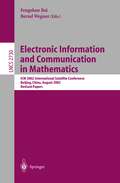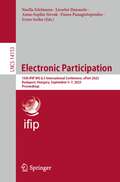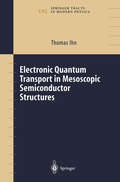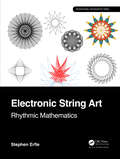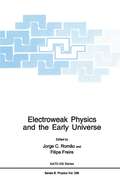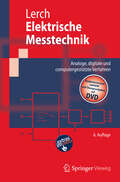- Table View
- List View
Electronic Government and the Information Systems Perspective: 13th International Conference, EGOVIS 2024, Naples, Italy, August 26–28, 2024, Proceedings (Lecture Notes in Computer Science #14913)
by Ismail Khalil A Min Tjoa Gabriele Kotsis Andrea KöThis book constitutes the proceedings of the 13th International Conference on Electronic Government and the Information Systems Perspective, EGOVIS 2024, which took place in Naples, Italy, in August 2024. The 10 full and 5 short papers included in this book were carefully reviewed and selected from 24 submissions. They were organized in topical sections as follows: AI in E-Government; E-Government cases; mobile government and digital inclusion; open government data and security.
Electronic Government and the Information Systems Perspective: 12th International Conference, EGOVIS 2023, Penang, Malaysia, August 28–30, 2023, Proceedings (Lecture Notes in Computer Science #14149)
by Andrea Kö Enrico Francesconi Adeleh Asemi Gabriele Kotsis A Min Tjoa Ismail KhalilThis book constitutes the proceedings of the 12th International Conference on Electronic Government and the Information Systems Perspective, EGOVIS 2023, which took place in Penang, Malaysia, during August 28-30, 2023.The 8 full papers presented together with 1 short paper were carefully reviewed and selected from a total of 17 submissions. They were organized in topical sections as follows: e-Government; strategy; artificial intelligence.
Electronic Information and Communication in Mathematics: ICM 2002 International Satellite Conference, Beijing, China, August 29-31, 2002, Revised Papers (Lecture Notes in Computer Science #2730)
by Fengshan Bai Bernd WegnerElectronic, Magnetic, and Thermoelectric Properties of Spinel Ferrite Systems: A Monte Carlo Study, Mean-Field Theory, High-Temperature Series Expansions, and Ab-Initio Calculations (SpringerBriefs in Materials)
by Rachid MasrourThis book explores magnetic properties and critical temperatures in inverse ferrite Fe₃⁺(M₂⁺Fe₃⁺)O₄ spinels (e.g., Fe, Co, Ni). It calculates transition and Curie Weiss temperatures, providing insights into their thermodynamic behavior. Using the full potential linearized augmented plane wave (FP-LAPW) method, it investigates electrical and magnetic structures of spinel chromite, revealing magnetic moments in MnCr₂S₄. Seebeck coefficient and electrical conductivity are also calculated. Advanced techniques like Monte Carlo, DFT+U, and FLAPW analyze magnetic characteristics of LiMn₁.₅Ni₀.₅O₄ and electronic/magnetic structures of Fe₃O₄. High-temperature series expansions calculate Néel temperature and critical exponents, while GFT determines thermal magnetization and susceptibility. The analysis exposes exchange interactions' effects on magnetic order and introduces asymmetric phases in ferrimagnetic spinel systems. This book serves as an invaluable resource for researchers, academics, and enthusiasts seeking a comprehensive understanding of magnetic properties and critical phenomena within diverse spinel materials.
Electronic Participation: 15th IFIP WG 8.5 International Conference, ePart 2023, Budapest, Hungary, September 5–7, 2023, Proceedings (Lecture Notes in Computer Science #14153)
by Noella Edelmann Lieselot Danneels Anna-Sophie Novak Panos Panagiotopoulos Iryna SushaThis book constitutes the proceedings of the 15th IFIP WG 8.5 International Conference on Electronic Participation, ePart 2023, held in Budapest, Hungary, in September 2023, in conjunction with the IFIP WG 8.5 Conference on Electronic Government (EGOV 2023) and the Conference for E-Democracy and Open Government Conference (CeDEM 2023). A total of 38 full papers has been carefully reviewed and selected from 106 submissions. Eight of the accepted papers are included in this book. They were organized in topical sections as follows: E-participation; digital transformation; digital technology; and digital sovereignty.
Electronic Participation: 16th IFIP WG 8.5 International Conference, ePart 2024, Ghent, Belgium, September 3–5, 2024, Proceedings (Lecture Notes in Computer Science #14891)
by Sara Hofmann Efthimios Tambouris Peter Parycek Thomas Lampoltshammer Csaba Csáki Gerhard Schwabe Marius Rohde Johannessen Jolien Ubacht Lieselot DanneelsThis book constitutes the refereed proceedings of the 16th IFIP WG 8.5 International Conference on Electronic Participation, ePart 2024, held in Ghent, Belgium, during September 3–5, 2024. The 15 full papers included in this book were carefully reviewed and selected from 35 submissions. The conference is dedicated to digital or electronic government, open government, local government (smart cities), smart governance, artificial intelligence (AI), e-democracy, policy informatics, and electronic participation.
Electronic Quantum Transport in Mesoscopic Semiconductor Structures (Springer Tracts in Modern Physics #192)
by Thomas IhnOpening with a brief historical account of electron transport from Ohm's law through transport in semiconductor nanostructures, this book discusses topics related to electronic quantum transport. The book is written for graduate students and researchers in the field of mesoscopic semiconductors or in semiconductor nanostructures. Highlights include review of the cryogenic scanning probe techniques applied to semiconductor nanostructures.
Electronic String Art: Rhythmic Mathematics (AK Peters/CRC Recreational Mathematics Series)
by Stephen ErfleString art is a well-known and popular activity that uses string, a board, and nails to produce artistic images (although there are variations that use different modalities). This activity is beloved because simple counting rules are used to create beautiful images that can both adorn walls and excite young minds. The downside of this highly tactile activity is that it is quite time-consuming and rigid. By contrast, electronic string art offers much more flexibility to set up or change nail locations and counting rules, and the images created from those changes change instantaneously.Electronic String Art: Rhythmic Mathematics invites readers to use the author’s digital resources available on the ESA website to play with the parameters inherent in string art models while offering concise, accessible explanations of the underlying mathematical principles regarding how the images were created and how they change. Readers will have the opportunity to create visually beautiful works of art while learning concepts from geometry, number theory, and modular arithmetic from approximately 200 short-interdependent sections.Features Readers are able to drill-down on images in order to understand why they work using short (1 to 2 page) stand-alone sections Sections are lessons that were created so that they could be digested in a single sitting These sections are stand-alone in the sense that they need not be read sequentially but can be referred to based on images that the reader finds interesting An open-ended, inherently flexible teaching resource for elementary, middle, and high school-level mathematics The most mathematically challenging sections (or portions of a section) are designated MA and may not be accessible to elementary and middle school readers Will be appreciated by anyone interested in recreational mathematics or mathematical artworks even if the users are not interested in the underlying mathematics Includes exercises, solutions, and many online digital resources These QR codes take you to these digital resources. One takes you directly to the web version of the string art model (used as a starting point for teaching the parameters of the model in Section 25.5). The other takes you to the ESA web page with additional links to a variety of resources.
Electronic Structure of Disordered Alloys, Surfaces and Interfaces
by Ilja Turek Václav Drchal Josef Kudrnovský Mojmír Sob Peter WeinbergerAt present, there is an increasing interest in the prediction of properties of classical and new materials such as substitutional alloys, their surfaces, and metallic or semiconductor multilayers. A detailed understanding based on a thus of the utmost importance for fu microscopic, parameter-free approach is ture developments in solid state physics and materials science. The interrela tion between electronic and structural properties at surfaces plays a key role for a microscopic understanding of phenomena as diverse as catalysis, corrosion, chemisorption and crystal growth. Remarkable progress has been made in the past 10-15 years in the understand ing of behavior of ideal crystals and their surfaces by relating their properties to the underlying electronic structure as determined from the first principles. Similar studies of complex systems like imperfect surfaces, interfaces, and mul tilayered structures seem to be accessible by now. Conventional band-structure methods, however, are of limited use because they require an excessive number of atoms per elementary cell, and are not able to account fully for e.g. substitu tional disorder and the true semiinfinite geometry of surfaces. Such problems can be solved more appropriately by Green function techniques and multiple scattering formalism.
Electronic Structure of Rare-Earth Nickelates from First-Principles (Springer Theses)
by Harrison LaBollitaThis thesis demonstrates the value of theoretical approaches in the discovery of new superconducting materials. It reports a detailed study of the recently discovered nickel-oxide (nickelate) superconductors using multiple first-principles computational tools, from density functional theory to dynamical mean field theory. In the context of superconductivity, discoveries have generally been linked to serendipitous experimental discovery; this thesis reports some of the few examples of predictions of new superconductors that have later been realized in practice, a prime example of the significance of the methodology it expounds. Overall, it represents a seminal systematic work in the electronic structure theory of the emergent field of nickelate superconductivity.
Electronics via Waveform Analysis
by Edwin C. CraigThe author believes that a good basic understanding of electronics can be achieved by detailed visual analyses of the actual voltage waveforms present in selected circuits. The voltage waveforms included in this text were photographed using a 35-rrun camera in an attempt to make the book more attractive. This book is intended for the use of students with a variety of backgrounds. For this reason considerable material has been placed in the Appendix for those students who find it useful. The Appendix includes many basic electricity and electronic concepts as well as mathematical derivations that are not vital to the understanding of the circuit being discussed in the text at that time. Also some derivations might be so long that, if included in the text, it could affect the concentration of the student on the circuit being studied. The author has tried to make the book comprehensive enough so that a student could use it as a self-study course, providing one has access to adequate laboratory equipment.
Electrorheological Fluids: Modeling and Mathematical Theory (Lecture Notes in Mathematics #1748)
by Michael RuzickaThis is the first book to present a model, based on rational mechanics of electrorheological fluids, that takes into account the complex interactions between the electromagnetic fields and the moving liquid. Several constitutive relations for the Cauchy stress tensor are discussed. The main part of the book is devoted to a mathematical investigation of a model possessing shear-dependent viscosities, proving the existence and uniqueness of weak and strong solutions for the steady and the unsteady case. The PDS systems investigated possess so-called non-standard growth conditions. Existence results for elliptic systems with non-standard growth conditions and with a nontrivial nonlinear r.h.s. and the first ever results for parabolic systems with a non-standard growth conditions are given for the first time. Written for advanced graduate students, as well as for researchers in the field, the discussion of both the modeling and the mathematics is self-contained.
Electrostatics (The Springer International Series in Engineering and Computer Science #700)
by Niels JonassenDesigned for non-specialists, this easy-to-read new edition provides a comprehensive and coherent account of static electric phenomena and concepts based on a mathematical-physical approach. It has been updated to include new and expanded material ranging from charge decay to electrostatic measurements.
Electroweak Physics and the Early Universe (Nato Science Series B: #338)
by Jorge C. Romão Filipe FreireProceedings of a NATO ARW held in Sintra, Portugal, March 23-25, 1994
Electroweak Physics at the Large Hadron Collider with the ATLAS Detector: Standard Model Measurement, Supersymmetry Searches, Excesses, and Upgrade Electronics (Springer Theses)
by Elodie ResseguieThis thesis discusses searches for electroweakly produced supersymmetric partners of the gauge and the Higgs bosons (gauginos and higgsinos) decaying to multiple leptons, using pp collisions at sqrt(s) = 13 TeV. The thesis presents an in-depth study of multiple searches, as well as the first 13 TeV cross section measurement for the dominant background in these searches, WZ production. Two searches were performed using 36.1/fb of data: the gaugino search, which makes use of a novel kinematic variable, and the higgsino search, which produced the first higgsino limits at the LHC. A search using 139/fb of data makes use of a new technique developed in this thesis to cross check an excess of data above the background expectation in a search using a Recursive Jigsaw Reconstruction technique. None of the searches showed a significant excess of data, and limits were expanded with respect to previous results.These searches will benefit from the addition of luminosity during HL-LHC; however, the current detector will not be able to withstand the increase in radiation. Electronics for the detector upgrade are tested and irradiated to ensure their performance.
Electroweak Symmetry Breaking: By Dynamically Generated Masses of Quarks and Leptons (Springer Theses)
by Mgr.Adam SmetanaWith this thesis the author contributes to the development of a non-mainstream but long-standing approach to electroweak symmetry breaking based on an analogy with superconductivity. Electroweak symmetry breaking is assumed to be caused by dynamically generated masses of typical fermions, i.e., of quarks and leptons, which in turn assumes a new dynamics between quarks and leptons. Primarily it is designed to generate fermion masses and electroweak symmetry breaking is an automatic consequence.After the summary of the topic, the first main part of the thesis addresses the question as to whether the masses of known quarks and leptons provide sufficiently strong sources of electroweak symmetry breaking. It is demonstrated that neutrino masses subject to the seesaw mechanism are indispensable ingredients. The other two parts of the thesis are dedicated to the presentation of two particular models: The first model is based on the new strong Yukawa dynamics and serves as a platform for studying the ability to reproduce fermion masses. The second, more realistic model introduces a flavor gauge dynamics and its phenomenological consequences are studied.Even though, in the past, this type of models has already been of some interest, following the discovery of the Standard-Model-like Higgs particle, it is regaining its relevance.
Elektrische Messtechnik: Analoge, digitale und computergestützte Verfahren
by Reinhard LerchDieses Lehrbuch bietet eine umfassende Einführung in die moderne Elektrische Messtechnik. Behandelt werden: die Fehlerrechnung systematischer und zufälliger Fehler, die Erfassung von dynamischen Messfehlern und ihren Korrekturen, Geräte und Verfahren der analogen Messtechnik, wie z.B. Standard-Messgeräte, elektronische Messverstärker, Messbrücken. Anschließend werden Analog-Digital- und Digital-Analog-Umsetzer sowie digitale Messgeräte beschrieben. Ein weiterer Schwerpunkt des Buches ist die ausführliche Behandlung der modernen computerunterstützten Messdatenerfassung und Messsignalverarbeitung bezüglich Hard- und Software. In der 7. Auflage wurde der neueste Stand auf dem Gebiet der automatisierten Messdatenerfassung aufgenommen. Dazu zählen insbesondere neuere Schnittstellen, wie z.B. Flexray, sowie die Erweiterung von Standardschnittstellen, z.B. CAN-Bus. Es ist eine DVD mit Übungsaufgaben zur rechnergestützten Messdatenerfassung und Messsignalverarbeitung sowie zur Programmierung von Speicherprogrammierbaren Steuerungen (SPS) enthalten. Via Internet kann der Leser eine am Lehrstuhl für Sensorik aufgebaute SPS programmieren sowie weitere Übungsaufgaben und Lösungen zu den Programmieraufgaben von der DVD herunterladen. Die DVD enthält außerdem eine Studentenversion von LabVIEW.Die ZielgruppenDas Buch eignet sich in Verbindung mit dem Werk "Elektrische Messtechnik/Übungsbuch" für Studierende der Ingenieur- und Naturwissenschaften sowie für den in der Praxis tätigen Ingenieur auch zum Selbststudium.
Elektrische Messtechnik: Analoge, digitale und computergestützte Verfahren (Springer-Lehrbuch)
by Reinhard LerchDas Lehrbuch bietet eine umfassende Einführung in die moderne elektrische Messtechnik. Behandelt werden Fehlerrechnung, Erfassung von dynamischen Messfehlern und ihren Korrekturen, Geräte und Verfahren der analogen Messtechnik, Analog-Digital- und Digital-Analog-Umsetzer sowie digitale Messgeräte. Kapitel zur rechnergestützten Messdatenerfassung wurden für die Neuauflage aktualisiert, Abschnitte zur Messsignalverarbeitung erweitert. Die DVD enthält Übungsaufgaben zur Messdatenerfassung und zur Programmierung von Speicherprogrammierbaren Steuerungen.
Elektrische Messtechnik: Analoge, digitale und computergestützte Verfahren (Springer-Lehrbuch)
by Reinhard LerchIntelligente und interaktive Einführung mit DVD: Sämtliche Kapitel der 4. Neuauflage sind ausführlich erläutert, erheblich erweitert und auf dem allerneuesten Stand. Die DVD bietet eine Studentenversion von LabVIEW 8.2.1 und Übungsaufgaben zur rechnergestützten Messdatenerfassung und -signalverarbeitung sowie zur Programmierung von Speicherprogrammierbaren Steuerungen (SPS). Via Internet können Leser eine am Lehrstuhl für Sensorik aufgebaute SPS programmieren sowie weitere Übungsaufgaben und Lösungen herunterladen. Umfassend erläutert der Autor die Fehlerrechnung systematischer und zufälliger Fehler, die Erfassung dynamischer Messfehler etc.
Elektrische Messtechnik: Analoge, digitale und computergestützte Verfahren (Springer-Lehrbuch)
by Reinhard LerchDas Lehrbuch führt umfassend in die moderne elektrische Messtechnik ein. Der Autor behandelt die Fehlerrechnung systematischer und zufälliger Fehler, die Erfassung von dynamischen Messfehlern und ihre Korrekturen, Geräte und Verfahren der analogen Messtechnik sowie digitale Messgeräte. Die Kapitel zur rechnergestützten Messdatenerfassung wurden für die 4. Auflage dem neuesten Stand der Technik angepasst, Abschnitte zur Messsignalverarbeitung erheblich erweitert. Die DVD enthält Übungsaufgaben sowie eine Studentenversion von LabVIEW 8.2.1.
Elektrodynamik: Von den Maxwell-Gleichungen über die Elektro- und Magnetostatik zur elektromagnetischen Induktion (essentials)
by Hans Dieter Dahmen Siegmund Brandt Claus Grupen Tilo StrohDieses essential konzentriert sich auf die Vermittlung der wichtigsten Grundbegriffe, von der Elektrostatik, den Phänomenen des elektrischen Stromes bis hin zu den Maxwell-Gleichungen und aus ihnen abgeleiteten Erkenntnissen. Begriffe wie Ladung, Coulomb-Kraft, Dipol, elektrisches Feld und Potential, magnetisches Feld, Lorentz-Kraft und die Wechselbeziehungen zwischen elektrischen und magnetischen Feldern wie die Induktion werden dargestellt. Auf die vielen Anwendungen der Elektrodynamik wird hingewiesen.
Elektrodynamik: Lehrbuch zur Theoretischen Physik II
by Torsten FließbachDieses Lehrbuch gibt eine Einführung in die Elektrodynamik und richtet sich an Studierende der Physik, die diese Vorlesung besuchen. Besonderen Wert hat Torsten Fließbach auf eine gut lesbare, verständliche und prägnante Darstellung gelegt. So werden die einzelnen Schritte ausführlich dargestellt und besprochen. Als Erstes werden die mathematischen Hilfsmittel für die Elektrodynamik kompakt zusammengefasst. Der zweite Teil behandelt die Elektrostatik, der dritte die Magnetostatik. Ausgehend vom Experiment werden die Feldgleichungen motiviert und unterschiedliche Lösungsmethoden diskutiert. Im vierten Teil wird die Maxwellsche Theorie behandelt, die die Kopplung von elektrischen und magnetischen Feldern zeitabhängig beschreiben. Besonderer Fokus liegt auf der relativistischen Struktur der Elektrodynamik, die ausführlich besprochen wird. Im fünften Teil werden Anwendungen wie beispielsweise Hohlraumwellen, die Strahlung beschleunigter Ladungen, Streuung von Licht und der Schwingkreis besprochen. Der sechste Teil beschäftigt sich mit der Aufstellung der mikroskopischen Maxwellgleichungen in Materie und der Ausbreitung elektromagnetischer Wellen in Materie. Im anschließenden Teil sind die grundlegenden Prinzipien der Optik zusammengefasst. Torsten Fließbachs Lehrbuchreihe zur Theoretischen Physik umfasst die folgenden Bände: Mechanik, Elektrodynamik, Quantenmechanik, Statistische Physik und ein begleitendes Arbeitsbuch. Außerdem ist von ihm das Buch „Die relativistische Masse“ erschienen.
Elektrodynamik
by Dietmar Petrascheck Franz SchwablMit diesem Werk wird die bekannte Lehrbuchreihe von Franz Schwabl um einen weiteren Band ergänzt. In diesem Band finden Sie eine präzise Einführung in die Elektrodynamik für Physiker - ergänzt um einen umfangreichen mathematischen Anhang, der das Lösen von Übungsaufgaben erleichtert.Die Elektrodynamik ist eine klassische Feldtheorie. Sie basiert auf den mikroskopischen Maxwell-Gleichungen und ist invariant unter der Lorentz-Transformation, dem Ausgangspunkt der speziellen Relativit ätstheorie. In Materie sind die Maxwell-Gleichungen durch Materialgleichungen zu erg änzen. Durch diese Ergänzungen erhält man ein weit gestreutes Anwendungsgebiet, das Elektro- und Magnetostatik, quasistation äre Vorg änge und elektromagnetische Wellen umfasst. In allen diesen Bereichen sind Bez üge zur Festk orperphysik gegeben, auf die die Autoren dieses Buches eingehen. Extra hingewiesen wird auch auf die dynamische Theorie der R öntgenstreuung, die im Kontext der Elektrodynamik sonst eher selten thematisiert wird. Aus dem Inhalt:Die Maxwellschen Feldgleichungen – Ruhende Ladungsverteilungen mit Leitern – Randwertprobleme in der Elektrostatik – Magnetostatik im Vakuum - Elektromagnetische Vorgänge in Materie – Elektrostatik in Materie – Magnetostatik in Materie – Felder von bewegten Ladungen – Quasistationäre Ströme – Elektromagnetische Wellen – Röntgenstreuung – Spezielle Relativitätstheorie – Relativistische Mechanik
Elektrodynamik
by Dietmar Petrascheck Franz SchwablMit diesem Werk wird die bekannte Lehrbuchreihe von Franz Schwabl um einen weiteren Band ergänzt. In diesem Band finden Sie eine präzise Einführung in die Elektrodynamik für Physiker - ergänzt um einen umfangreichen mathematischen Anhang, der das Lösen von Übungsaufgaben erleichtert. Die Elektrodynamik ist eine klassische Feldtheorie. Sie basiert auf den mikroskopischen Maxwell-Gleichungen und ist invariant unter der Lorentz-Transformation, dem Ausgangspunkt der speziellen Relativitätstheorie. In Materie sind die Maxwell-Gleichungen durch Materialgleichungen zu ergänzen. Durch diese Ergänzungen erhält man ein weit gestreutes Anwendungsgebiet, das Elektro- und Magnetostatik, quasistationäre Vorgänge und elektromagnetische Wellen umfasst. In allen diesen Bereichen sind Bezüge zur Festkörperphysik gegeben, auf die die Autoren dieses Buches eingehen. Extra hingewiesen wird auch auf die dynamische Theorie der Röntgenstreuung, die im Kontext der Elektrodynamik sonst eher selten thematisiert wird. Die vorliegende zweite Auflage wurde überarbeitet und korrigiert. Aus dem Inhalt: Die Maxwellschen Feldgleichungen – Ruhende Ladungsverteilungen mit Leitern – Randwertprobleme in der Elektrostatik – Magnetostatik im Vakuum - Elektromagnetische Vorgänge in Materie – Elektrostatik in Materie – Magnetostatik in Materie – Felder von bewegten Ladungen – Quasistationäre Ströme – Elektromagnetische Wellen – Röntgenstreuung – Spezielle Relativitätstheorie – Relativistische Mechanik
Elektrodynamik
by Dietmar Petrascheck Franz SchwablDieses Lehrbuch behandelt präzise und ausführlich die klassische Elektrodynamik, wie sie für das Physik-Studium erforderlich ist. Es beginnt mit einer detaillierten Beschreibung der Maxwell-Gleichungen, so dass die Grundlagen für die verschiedenen Anwendungsgebiete geschaffen sind: Elektro- und Magnetostatik im Vakuum und in Materie und die Strahlung elektromagnetischer Wellen. Gerade der dynamischen Theorie der Röntgenstrahlung und der speziellen Relativitätstheorie wird dabei ein längerer Abschnitt eingeräumt. Zudem schlägt das Werk in vielen Bereichen eine Brücke zu den entsprechenden Fragestellungen der Festkörperphysik.Die Herleitung einiger Formeln sowie weitere Fragestellungen finden sich am Ende eines jeden Kapitels in den Übungsaufgaben, deren Lösungen online zugänglich sind. Im Anhang findet sich eine umfangreiche Zusammenfassung der notwendigen mathematischen Grundlagen. Als besondere Neuerung sind in der vorliegenden dritten Auflage alle Formeln so gehalten, dass sie für das SI-, Gauß- und Heaviside-Lorentz-System gleichermaßen gelten. Das erleichtert den Wechsel zwischen den Systemen und ermöglicht ein Verständnis dafür, wo und wie die Einheitensysteme eingreifen.Aus dem InhaltDie Maxwell´schen Feldgleichungen – Ruhende Ladungsverteilungen auf Leitern – Randwertprobleme in der Elektrostatik – Magnetostatik im Vakuum – Elektromagnetische Vorgänge in Materie – Elektrostatik in Materie – Magnetostatik in Materie – Felder von bewegten Ladungen – Quasistationäre Ströme – Elektromagnetische Wellen – Röntgenstreuung – Spezielle Relativitätstheorie – Kovariante Elektrodynamik – Relativistische Mechanik


